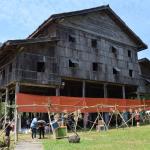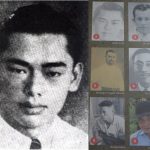Santubong Peninsula, with its rich history and great landscape is only a 35-minute drive from Kuching.
Behind its mountain peaks lies an age-old legend of jealousy and rage between Puteri Santubong and her sister Puteri Sejinjang.
Hailing from a celestial kingdom, the princesses were not above sibling rivalry. One fateful day, the princesses fought violently with each other over who was the more beautiful.
Sejinjang hit Santubong’s head, after which the latter fell to the earth, becoming Mount Santubong.
Before she fell, however, she managed to throw the beam of her weaving loom at Sejinjang. The impact broke Sejinjang’s body, and the pieces scattered into the ocean, forming nearby islands Pulau Satang, Pulau Talang-Talang and so on.
With the family feud in the mythical past, Santubong is a famous place for both locals and foreign tourists alike, the beauty of these two sisters still living on to this day through the scenic views of both the rainforest and the South China Sea.
Here are 10 things to do while visiting the Santubong Peninsula:
1. Climb Mount Santubong

The number one thing to do (provided you have the passion and stamina) is to climb to the Santubong summit.
It is moderately difficult since it has some steep climbs assisted by rope ladders.
The climb takes about 3 to 4 hours to the summit and up to 3 hours to hike down.
Do not take the climb lightly as there have been cases of climbers becoming stranded out of exhaustion.
It is advisable to depart from the park rangers’ office no later than 8am and take at least 3 litres of water for each person.
Nonetheless, the views from the top are definitely rewarding.

2. No energy to climb to the top? Just hike around it.
If you don’t have the energy to climb to the top but still want to enjoy the rainforest, hike around it.
At Santubong National Park, you can either follow the red trail up to the summit or the blue trail for an easier alternative.
The blue trail takes around two hours to complete and will lead you to one of the waterfalls.

3. Take a dip in one of the jungle pools
While you are paying Mother Nature a visit, you might at as well take a refreshing dip in one of its jungle pools.
Both blue and red trails at the national park have waterfalls to offer.
The waters are relatively shallow at all the waterfalls and may be only waist-deep at most.

4. Explore the coastline, not just Damai Beach
Apart from Damai Beach, there is another less famous but equally beautiful beach located at Santubong Peninsula.
Situated at Kampung Santubong, Pantai Puteri offers a scenic view of its coast.
It is a great place for beach combing as you can walk as far as the mouth of Santubong River.
There are plenty of weird-looking rock formations to explore as you draw closer to the estuary.
Be alert to your surroundings because if you are lucky enough, you might spot a kingfisher or two.
Here are some photos taken at Pantai Puteri:
5. Kayak along the shoreline
Another way to enjoy the shoreline is to kayak along it.
Permai Beach Resort and Damai Beach Resort offer kayaks for rent at affordable prices.
There are other recreational activities as well such as scuba diving, snorkelling and stand up paddleboards.
Each of them allows visitors to look at Santubong from different perspectives.

6. Have a taste of Sarawak culture
Visiting a new place would not be complete without having a taste of its culture.
Sarawak Cultural Village (SCV) is an award-winning living museum depicting the cultural heritage of major racial groups in Sarawak.
There are seven unique houses which invite visitors to have an insight of the traditional life: the Bidayuh longhouse, Iban longhouse, Orang Ulu longhouse, Chinese farmhouse, Melanau tall house, Malay house and Penan hut.
Do not miss their cultural performances held at its theater twice a day at 11.30 and 4pm.
Once a year, SCV also plays host to the world renowned Rainforest World Music Festival.

7. Swim in the South China Sea
Put on your bikinis or swimming trunks and just have a swim – but don’t forget to put on some sunscreen first!

8. Visit historical sites
The history of Santubong can be traced as far back as the 7th century.
The artifacts found in the area shows that the peninsula was a trading port between Borneo and China.
One of the historical places to visit at Santubong is Sultan Tengah Mausoleum.
It is located right before the junction to Santubong village.
The first and only Sultan of Sarawak, Sultan Tengah died in 1641 and was buried together with his family members.
Other historical sites include Batu Bergambar near Sungai Jaong, Cursed Crocodile Stone in Santubong village and archaeological site of Bongkisam.

9. Explore Damai Craftworld and Event Centre
It was formerly known and still preferably called Damai Central.
The place has wide variety of facilities and services to offer which include barbecue pits, camp ground, event venues, food courts and crafts bazaars.

10. Sit back, have a beer and enjoy the sunset
This is perhaps the best thing to do at Santubong.
Plop down on one of the seats at Escobar at Damai Craftworld and Event Centre, have a sip of a cold beer and then simply enjoy the sunset.
































































